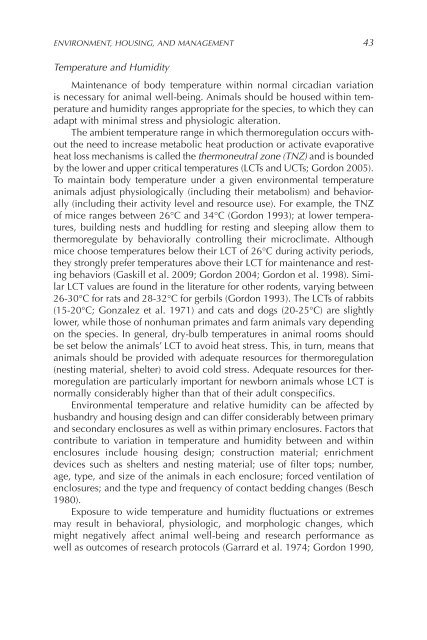Guide for the Care and Use of Laboratory Animals - Office of ...
Guide for the Care and Use of Laboratory Animals - Office of ...
Guide for the Care and Use of Laboratory Animals - Office of ...
- No tags were found...
You also want an ePaper? Increase the reach of your titles
YUMPU automatically turns print PDFs into web optimized ePapers that Google loves.
ENVIRONMENT, hOUSING, ANd MANAGEMENT 43Temperature <strong>and</strong> humidityMaintenance <strong>of</strong> body temperature within normal circadian variationis necessary <strong>for</strong> animal well-being. <strong>Animals</strong> should be housed within temperature<strong>and</strong> humidity ranges appropriate <strong>for</strong> <strong>the</strong> species, to which <strong>the</strong>y canadapt with minimal stress <strong>and</strong> physiologic alteration.The ambient temperature range in which <strong>the</strong>rmoregulation occurs without<strong>the</strong> need to increase metabolic heat production or activate evaporativeheat loss mechanisms is called <strong>the</strong> <strong>the</strong>rmoneutral zone (TNZ) <strong>and</strong> is boundedby <strong>the</strong> lower <strong>and</strong> upper critical temperatures (LCTs <strong>and</strong> UCTs; Gordon 2005).To maintain body temperature under a given environmental temperatureanimals adjust physiologically (including <strong>the</strong>ir metabolism) <strong>and</strong> behaviorally(including <strong>the</strong>ir activity level <strong>and</strong> resource use). For example, <strong>the</strong> TNZ<strong>of</strong> mice ranges between 26°C <strong>and</strong> 34°C (Gordon 1993); at lower temperatures,building nests <strong>and</strong> huddling <strong>for</strong> resting <strong>and</strong> sleeping allow <strong>the</strong>m to<strong>the</strong>rmoregulate by behaviorally controlling <strong>the</strong>ir microclimate. Althoughmice choose temperatures below <strong>the</strong>ir LCT <strong>of</strong> 26°C during activity periods,<strong>the</strong>y strongly prefer temperatures above <strong>the</strong>ir LCT <strong>for</strong> maintenance <strong>and</strong> restingbehaviors (Gaskill et al. 2009; Gordon 2004; Gordon et al. 1998). SimilarLCT values are found in <strong>the</strong> literature <strong>for</strong> o<strong>the</strong>r rodents, varying between26-30°C <strong>for</strong> rats <strong>and</strong> 28-32°C <strong>for</strong> gerbils (Gordon 1993). The LCTs <strong>of</strong> rabbits(15-20°C; Gonzalez et al. 1971) <strong>and</strong> cats <strong>and</strong> dogs (20-25°C) are slightlylower, while those <strong>of</strong> nonhuman primates <strong>and</strong> farm animals vary dependingon <strong>the</strong> species. In general, dry-bulb temperatures in animal rooms shouldbe set below <strong>the</strong> animals’ LCT to avoid heat stress. This, in turn, means thatanimals should be provided with adequate resources <strong>for</strong> <strong>the</strong>rmoregulation(nesting material, shelter) to avoid cold stress. Adequate resources <strong>for</strong> <strong>the</strong>rmoregulationare particularly important <strong>for</strong> newborn animals whose LCT isnormally considerably higher than that <strong>of</strong> <strong>the</strong>ir adult conspecifics.Environmental temperature <strong>and</strong> relative humidity can be affected byhusb<strong>and</strong>ry <strong>and</strong> housing design <strong>and</strong> can differ considerably between primary<strong>and</strong> secondary enclosures as well as within primary enclosures. Factors thatcontribute to variation in temperature <strong>and</strong> humidity between <strong>and</strong> withinenclosures include housing design; construction material; enrichmentdevices such as shelters <strong>and</strong> nesting material; use <strong>of</strong> filter tops; number,age, type, <strong>and</strong> size <strong>of</strong> <strong>the</strong> animals in each enclosure; <strong>for</strong>ced ventilation <strong>of</strong>enclosures; <strong>and</strong> <strong>the</strong> type <strong>and</strong> frequency <strong>of</strong> contact bedding changes (Besch1980).Exposure to wide temperature <strong>and</strong> humidity fluctuations or extremesmay result in behavioral, physiologic, <strong>and</strong> morphologic changes, whichmight negatively affect animal well-being <strong>and</strong> research per<strong>for</strong>mance aswell as outcomes <strong>of</strong> research protocols (Garrard et al. 1974; Gordon 1990,
















